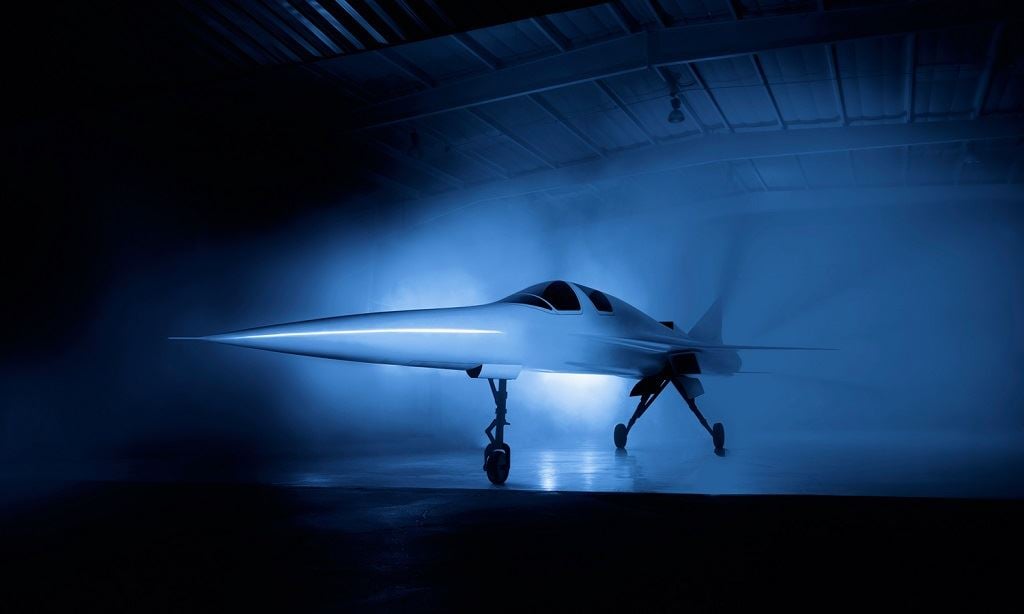![The XB-1 supersonic demonstrator aircraft [Image: Boom Supersonic]](https://fabbaloo.com/wp-content/uploads/2020/05/xb-1boom_img_5eb09530b1664.jpg)
Boom Supersonic is bringing metal 3D printing into its Mach 2.2 air travel plans.
The Colorado-based company recently deepened its relationship with Stratasys, signing a seven-year agreement for use of FDM technology. Today Boom goes farther, announcing its partnership with VELO3D to bring metal into the plans.
The release notes:
“Boom and VELO3D have already conducted validation trials, which performed accurately and to desired results. Now, VELO3D is developing two titanium flight hardware parts for XB-1, which will be installed on the prototype aircraft in early 2020. These 3D-printed parts are installed as part of the ECS system and ensure the aircraft can achieve safe flight at all conditions.”
Mach 2.2 Travel
Boom is targeting Mach 2.2 travel speed, with the 1,687mph capabilities taking an NYC-to-London flight from seven hours down to just three and a quarter hours.
XB-1 is Boom’s two-seater supersonic demonstrator aircraft: they call it “Baby Boom”. It’s a subscale prototype of the eventually passenger-ready Overture craft that will be Boom’s real entry into supersonic air travel.
Boom has noted several important technologies coming together as the XB-1 prepares for supersonic flight testing next year, as precision is critical. VELO3D’s Intelligent Fusion technology sounds like a good fit, then, as it was designed with precision in mind with emphasis on process control.
VELO3D Booms
For its part, VELO3D has held aerospace as one of its target markets since its inception, further making this partnership a good fit. This relationship has already yielded the first 3D printed metal parts for the XB-1 — or for any faster-than-the-speed-of-sound aircraft.
While we know two titanium flight hardware parts in the ECS (environmental control system) have been made now, we’ll have to wait for additional detail until the XB-1 is officially in the air.
“VELO3D helped us understand the capabilities and limitations of metal additive manufacturing and the positive impact it would potentially have on our supersonic aircraft. We look forward to sharing details about the aircraft development and improved system performance once XB-1 takes flight,” said Mike Jagemann, Head of XB-1 Production, Boom Supersonic.
3D Printing in Aircraft
Aviation is a booming — no pun intended — area for 3D printing in general. With more technologies gaining FAA approval, more 3D printing processes and 3D printed materials are taking to the skies each year.
Some of the lowest hanging fruit included fairly simple, non-mission-critical parts: tray tables, overhead compartment covers, dividing walls, panel covers. These have been mostly plastic parts 3D printed for interior use.
And then, of course, came the GE fuel nozzle, which put metal 3D printing on the aviation map for in-engine use. Just as in the above uses, lightweighting and part consolidation were on display, but something new began to emerge: metal 3D printed parts in operating environments.
As 3D printing suppliers began to work toward qualifying more parts, airlines began to pay much closer attention. Now, if anything, we’re tired of hearing about the GE fuel nozzle: it’s old news, so much as anything just a few years old can be. Now there are more engine parts, even full engines, that have been 3D printed for aerospace applications.
Boom Supersonic is looking to rethink commercial air travel, and that’s exactly the kind of rethinking that suits additive manufacturing nicely.
Announcing work with Stratasys and with VELO3D shows that Boom is casting a wide net, encompassing both polymer and metal 3D printing technologies — and these are only the partners they’ve talked about so far. There could be more. I’d be very surprised if Boom engineers didn’t have a few desktop 3D printers around as they work toward the tooling and hardware applications they’ve announced.
The XB-1 is set to come out later this year, with travel slated for 2020; the company is eyeing the mid-2020s for travel via the Overture.
Via VELO3D and Boom Supersonic











